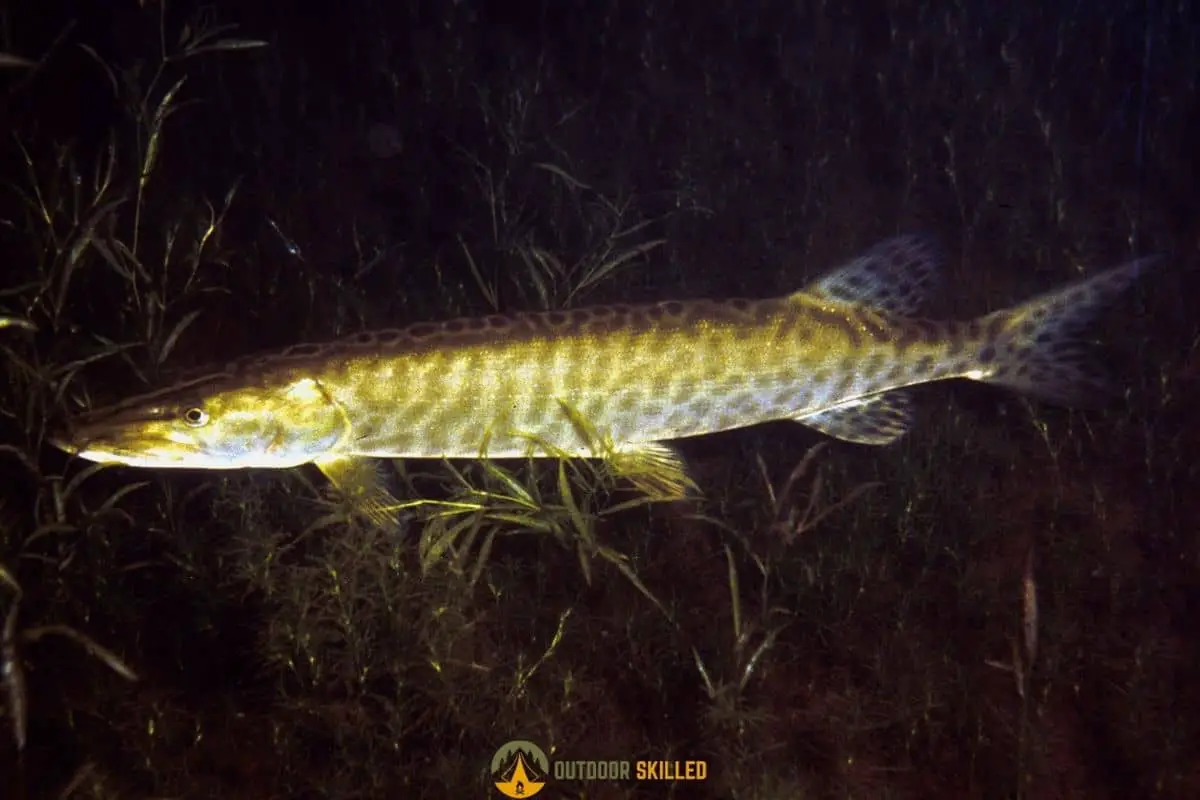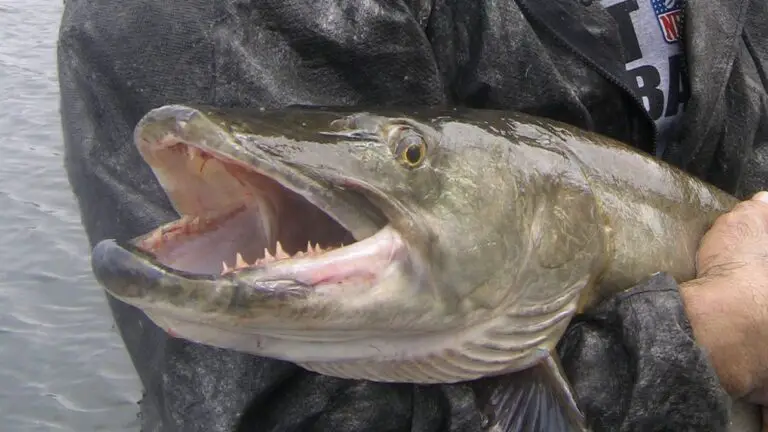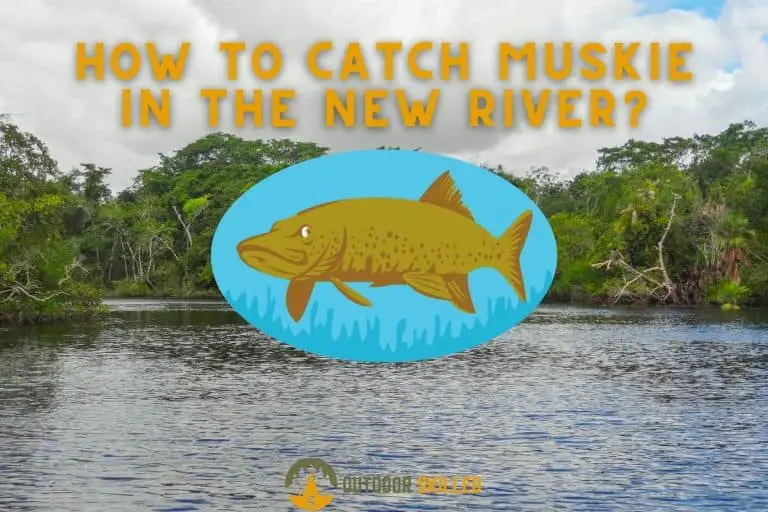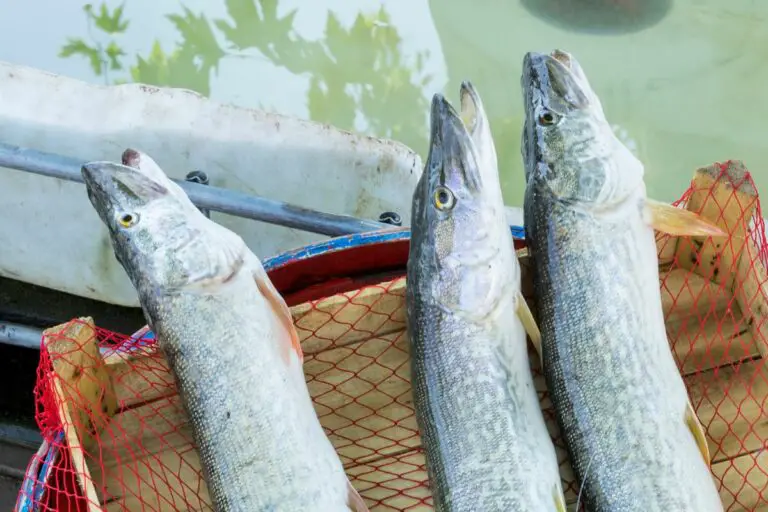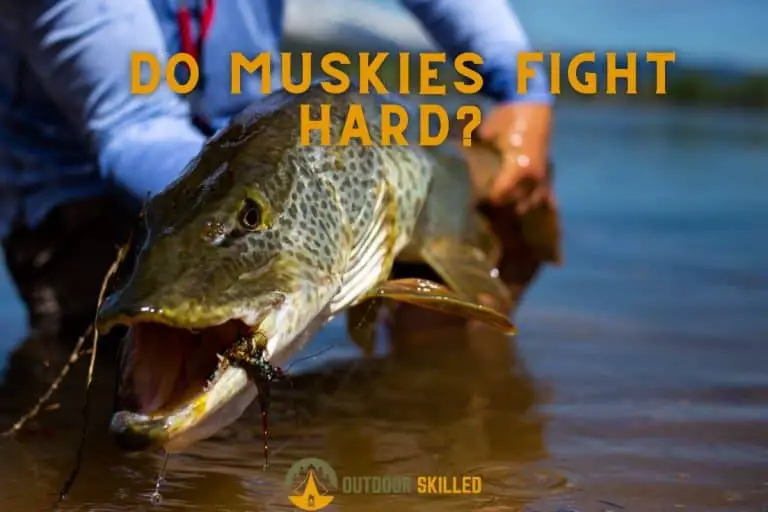How to Fish Muskie in The Spring? An Actually Helpful Guide
Muskie fishing is a prime activity in spring for everyone who is willing to have some adrenaline rush before summer. Spring fishing for muskie can be as exciting as any other season with the advantage of finding them in the shallows looking for an easy meal.
So, how to fish muskie in the spring? To fish muskies in the spring, target them in the basin at modest depths, maybe 10 to 15 feet (3-to-4.5 meters) down in clear lakes, shallower in ones with darker murky water. Look near schools of baitfish with search baits and use electronics to spot these fish markings.
Keep reading to learn more about spring fishing for muskies through this helpful guide. You can also upgrade your gear now with my picks for the 7 best musky reels here.
Table of Contents
How to fish muskie in the spring

Spring means spawning for muskies. If you live in a place where there are no regulations to fish for muskies in spring near the spawning period, you might be in luck. During this time, muskies migrate to the shallow waters to lay their eggs, and finding them requires minimal effort.
Muskie spawning takes place as water temperatures reach the mid-to-upper 50s. They are broadcast spawners, laying their eggs in shallow, soft-bottomed areas such as bays with inlet flow, shoreline areas, and off-current shallows in rivers.
You might be wondering; if they hit these places to spawn where do they go next for the rest of spring? The answer is that they stay where they are most of the time so if you missed the off-spawn period you can still look in these places even in summer.
If you didn’t have any luck finding them there, that could be because they spread out after spawning is done. Consider the shorelines leading out and any surrounding shallow structures to be natural travel zones and holding areas, particularly if cover such as wood, weeds, and rocks is available.
We established that you generally look near structures in the shallows. But since shallows vary from a water body to another, it’s safer to start searching 10 feet (3 meters) from the surface and go deeper if you came back empty-handed.
Going deeper is also a good idea if you’re fishing in a river with the heavy current because let me tell you, muskies don’t like to push against it. Muskies can tuck away from the current waiting to see what it can bring them. They stay either behind the structure or on the bottom, allowing the current to wash over them.
Muskie Seasonal patterns
Muskies respond to season changes like any other creature. They migrate up and down the water column depending on the weather and water temperature. So to find them, you must consider the season you’re fishing in.
In summer
Muskies will abandon deeper water to eat in weed beds. The best locations are weed beds near deep water. Mornings and evenings are the perfect hours. Muskies can suspend in shallow water, so trolling with big deep-running plugs is a good idea this time of year.
In winter
Look for rocks or wood above deep water as the water temperature decreases. In the winter, vegetation and weed edges will still be productive; if you’re unsuccessful there, move on to deeper water, where you’ll find suspended trophy muskies. The perfect time to catch muskies is in the mid-afternoon.
In fall
That is when the water temperature decreases and muskies have to eat heavily in order to gain weight before winter. Many muskie anglers believe that September and October are peak trophy months, and your odds of hooking one are extremely good. Concentrate on the afternoons and early evenings as the air begins to cool.
In spring
Smaller, shallower lakes have a greater chance. Muskies will congregate in shallower water, which easily warms and draws spawning minnows. Late mornings, early afternoons, and later in the day when the water warms up are the perfect times.
The best way to fish for muskie in the spring
The best way to catch muskie in the spring is using heavy gear and smaller baits. What you’ll need is 6-to-8 feet (1.8-to-2.5 meters) medium-heavy rod, a good quality reel that balances your rod, live bait like minnows, or small artificial lures like bucktails, and crankbaits.
Cast your lures or baits in the 10 feet (3 meters) depth and work it slow and steady. Smaller crankbaits, jerkbaits, spinners, and soft plastics are deadly this time of the year. Small minnows are an excellent choice as well as it represents the muskie forage in the shallows.
Best time of the day to catch muskie
So, what are the best times of the day to catch muskie in spring? The best times of the day to catch muskie in spring are the late afternoon and early mornings when the weather conditions are more close to summer. You’ll find them actively feeding in the shallows chasing baitfish schools.
Early in the spring, when the water is warmest, fish in the late afternoon. Later in the spring, fish in the early morning and late afternoon as the temperature most closely resembles that of summer. Early spring is one of the best times of year for musky fishing.
Muskies, among other fish, will push into the shallows in early spring, hunting down schools of bait. After a long winter and in readiness for spring, they would be ready to eat.
Spring Muskie Night Fishing
So, can you catch spring muskie at night? Yes, you can catch spring muskie at night. You can try different tactics but trolling seems the one to work most of the time. Troll for spring muskies at a 1-mph (1.6 km/h) speed in the depth of 5-to-8 ft (1.5-to-2.5 meters)
Trolling for muskies at night is a good bet. Especially in the spring where they stay in the shallows most of the time. Getting your gear, speed, and depth right is your way to catch trophy muskies on spring nights.
You’ll need several medium-heavy fast action rods, the number should be according to what your state allows, a reel of 6.2:1 gear ratio, small baits such as crankbaits, bucktails, and soft plastics, a planer board, a depth finder, and a transducer. Moving at a speed of 1-mph (1.6 km/h) is ideal. Make sure to keep your bait or lure in the strike zone of 5-to-8 ft (1.5-to-2.5 meters) deep.
You can check the best portable fish finders here.
Best baits for muskies in the spring

White suckers
Muskies go for white suckers of any size. Muskies are heavily feeding on them during this time of the year being an easy-to-catch high-on-protein fish. You can choose its size to match the muskie you’re going for. The range of 8-to-12 inches (about 20-to-30.5 cm) long is more popular. White sucker will live for a day, or longer in a bigger, well-aerated tank.
Minnows
Considering the fact that minnows are found in the shallows at the same time muskie stay, they’re considered a great choice to draw muskie to you. They feed heavily on them after the off-spawn period. Their natural scent and motion in the water are unmatched and irresistible to muskie.
Best lures for muskies in the spring
Topwater
Topwater lures are ideal when the water starts to warm up; which means they’re more than ideal in spring. Topwater baits of the prop-style and “walk-the-dog” type are recommended. Prop-style baits can be retrieved with a straight crank. While “walk the dog” should be retrieved in a side-to-side motion with little to no delay between pulls.
Soft plastics
They may not resemble any fish muskie go after but they’re very productive in a way that tackles the predatory nature of muskies. They imitate a dying fish when retrieved in a pull-stop way and that’s exactly what muskie want during this time of the year; an easy meal.
Bucktails
It is unquestionably the most common bait used by muskie anglers. Bucktails cause vibrations in the water that a musky’s lateral line can quickly detect. Depending on the circumstances, bucktails may be retrieved at any speed to appeal to muskie.
Crankbait
By far the most versatile lures for muskie. You can cast or troll them at any depth with any retrieval speed and they’ll get muskie to strike in no time. They have a variety of retrieves, including straight, twitched, and pull-stop. You can learn more about them in this crankbait vs jerkbait comparison.
How to troll for muskies in the spring
Techniques are important in catching muskies, but so is equipment. Trolling for muskies with inadequate equipment will derail the whole process; these fish are large and aggressive, and the added speed of the boat can result in line cutting.
So, what will you need to troll for muskies in spring? What you’ll need to troll for muskies in spring is:
- multiple 8-to-9 feet medium-heavy rods with forgiving tapers.
- A lead-core fishing line
- 3-to-4 ft wire leader
- Reels with a 6.2:1 gear ratio.
- Planer boards for spreading.
- Bucktails or Crankbait.
- Sonar machines and transducers.
The medium-heavy rods, the lead-core line, the wire leader, bait, and the reels suggested above are chosen to withstand the heavy duties trolling requires so you don’t have to worry the next time muskies fight you or try to get away.
Pro-Tip: choose your reel with line counters to determine how deep your bait is and be able to change it accurately when required. I recommend Okuma Magda Pro on Amazon.

It’s important to start casting in your lures where your fish might be. That’s where sonar machines come in handy. Spring muskies are often found in open waters most of the time, you’ll find them deeper than 8 feet (2.4 meters) into the water, maybe 10 or 15 feet (3-to-4.5 meters) deep, and to maximize your chances, stay near weed edges and rock structures.
Muskies can be unpredictable at times, so be prepared to change your plans on the fly. Using several trolling rods can be very useful in this situation; if you use a trolling set-up of four, six, or eight rods, vary the depth of the lure accordingly on each rod. Check your local regulations of using multiple rods before you go trolling.
It is preferable to follow your sonar machine, which identifies fish activities and markings. Cast your first lure, then set other lures to be deeper or shallower than this one. The lead core line gives you more depth access, which will help you change your strategy.
You can choose from a wide variety of lures, but crankbaits are the most versatile one during this time. It can be cast or trolled, with a variety of retrieves, including straight, twitched, and pull-stop.
If you are going to troll for muskie at night, check out my full guide on trolling for muskie fish at night here.
Pre-spawn VS Post-Spawn Muskie Fishing
Pre-spawn
During this time, the temperature of the shallows becomes greater than the water temperature of the drop-offs and open water, the muskies move up to the warmer, shallower water. So your strike zones are no deeper than 10 feet (3 meters) or so.
Females eat a lot to make sure their bodies have enough nutrients and resources to make the eggs they’ll be releasing soon. So to successfully catch one, keep your bait small and work it slow to entice them to strike.
Fish the shallow sand or weed flats with small glide baits, crankbaits, swimbaits, and even soft plastics during constant mild conditions or warming patterns spring.
Post-spawn
After the muskies have recovered from spawning, which is an exhausting process, they are only concerned about heavy feeding. It is suggested that you use your electronics to locate the bait schools. This will be determined by the primary forage in your lake. Bucktails, soft plastics, and topwater baits are the most common at this time of year.
Your strike zones stay in the shallows and near structures where they might stay throughout the summer as well.
River Muskie Fishing
To successfully catch muskie in rivers you need:
- An 8-foot (about 2.5 meters) medium heavy rod with fast action.
- Baitcasting reel with a 6.4 gear ratio.
- An 80-lb. (36 KG) braided line, tipped with an 80-lb (36 KG) fluorocarbon leader.
- Release tools for safety.
- Big Muskie net.
Crankbaits and soft plastics are your go-to in the colder weather when they’re actively feeding. Fall and winter are the seasons when muskies are targeting larger prey like suckers. While using an inline spinner is a good choice in warmer weather when you cast them in deep water where muskie tend to stay on warm sunny days.
Jerk bait can work any time of the year, but on the other hand, it’s not easy to work with. If this is your first time, don’t go for it and expect satisfying results.
If you are a fan of live bait, you can use them as well. Combining live bait with artificial lures can be very effective in catching muskies. Anglers prefer to use live bait such as suckers, shad, or carp.
Look near the structures in the river you’re fishing in. if the river is one with heavy current, it’s better to look deeper as well. Muskies will hide from the current as they wait to see what it has in store for them. They either remain behind the structure or at the bottom, allowing the current to flow over them.
As you can see, catching muskies is definitely not easy, but I would argue that it’s worth it. Even if you are not a big fan of the adrenaline and rush that comes from catching a big, tough fish, your body will definitely appreciate the health benefits of Muskies.
Related Questions
Where Do River Muskies Spawn?
Muskie spawn in aquatic weed beds and backwater eddies covered in leaves, as well as leaf mats, gravel bottoms in shallow bays and coves of lakes, or slack pools. Muskies spawn naturally in the New River only, while in other rivers they migrate from larger reservoirs.
What Is The Best Time To Fish For Muskie With Live Bait?
The best time to fish for muskie with live bait is during the fall. Muskies tend to feed heavily before winter. When the water hits the 50F mark (10C), live bait fishing for muskies becomes more effective.
What Size Muskie Can You Keep?
The muskie size you can keep is 50 inches (1.3 meters), according to a survey done by WDNR and collected from all species fishermen. The majority of muskie anglers are willing to keep a muskie if they’re considered a trophy, that has to be 50 inches (1.3 meters) or larger.
What’s The Ideal Number Of Rods To Use When Trolling For Muskies?
The ideal number of rods you can use when trolling for muskies is restricted by the regulation of the state you’re fishing in. If you put that aside, the four rods set up is a good choice, it offers huge coverage and is easy to manage on the boat.
Helpful Resources
Hunting Musky with a Fly – A Book by Rick Kustich
If you like this article, please share it or pin it, you can find the share buttons below. We will really appreciate it ❤️

